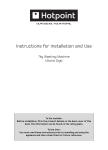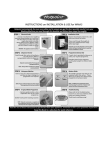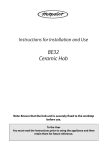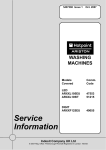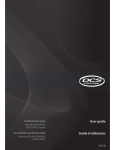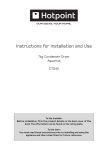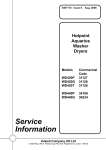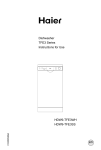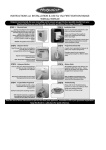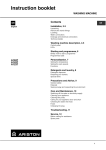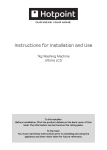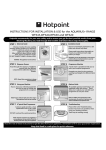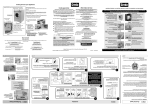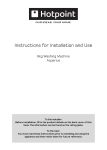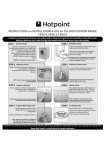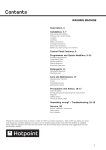Download Installation and Troubleshooting Guide
Transcript
Installation and Troubleshooting Guide Description GB Dispenser drawer Control panel (● Varies by Model) ● Please record the Model number and Serial number of your machine on the back cover of this book for future reference. Interlocking door and release lever. Drainage hose Cold water inlet point and attached fill hose (blue connector) Mains cable Front adjustable feet Hooked end support Plumbing indicator line Two transit fixings ! BOTH must be removed BEFORE you use your machine (see page 5). Rating plate ! The machine was designed and built in compliance with the applicable international safety regulations. The following information is provided for your safety and should consequently be read carefully. 2 Back feet Contents GB Description, 2 Description Installation, 4-7 Contents Unpacking Remove the transit fixings Location Levelling Water connection Drainage connection Electrical connection Before you start using your machine Detergents and Laundry, 8 Installation Detergent dispenser Washcare tips Preparing your laundry Precautions and Advice, 9 General safety Saving energy and respecting the environment Disposal Detergents and Laundry Care and Maintenance, 10 Cleaning your machine Fuses Changing the plug Cleaning the pump Precautions and Advice Troubleshooting, 11 Service, 12 Before calling for assistance Spare parts Key Contacts Care and Maintenance Troubleshooting Service 3 Installation GB 5. Remove the polystyrene base. ! Keep this instruction book on hand in order to refer to it when necessary. Take it with you when you move, and should you sell this appliance or pass it on to another party, make sure that this booklet is supplied along with the appliance so that the new owner may be informed about warnings and suggestions on how the machine works. Unpacking ! IMPORTANT check when unpacking your machine: 1. Using scissors, cut carefully along one corner post to remove the film. ● 2. Open the door and check inside the drum. Remove the transit tube (if applicable - not all models). ! Retain all packaging material until installation is complete. 3. Lift off the polystyrene top cap and remove the four corner posts. ! This is a part of the polystyrene base and should have stayed intact when you removed the base. If it has broken off and is still in the machine... remove it... while the machine is still laying on its side on the top cap. 6. Cut out the perforated shape in the transit tube you removed from the drum (if applicable - see Step 2). Follow instructions listed on the cut out to fit it to the base of the machine. When fitted this panel aids noise reduction. 7. Stand the machine upright. ! We recommend that a second person helps to raise and lower the machine. 4. Carefully lay the left side of the machine down onto the top cap. ! We recommend that a second person helps to raise and lower the machine. 4 ! Protect the environment - please dispose of the packaging material carefully and considerately. ! Continue to read the rest of these instructions carefully; the following pages contain important information on installation and troubleshooting. Installation ! Packaging materials are not children's toys. IMPORTANT: Follow these instructions to remove the TWO transit fixings (see Description for location). Situated one either side of the rear panel, BOTH transit bolts MUST be removed before use. ! Failure to do so may cause damage to your machine. It is important the transit bolt and spacer (see pic) come out intact. Location Where you install your machine will affect its performance: ! For your safety and to comply with electrical regulations, seek professional advice if you want to install your machine in a bath or shower room. ● ● 2. STOP when 3 threads can be seen. Installation ● Make sure that the electrical socket and water taps are easily accessible. You should switch off the machine’s electrical and water supplies when you are not using it for extended periods. Make sure that you allow enough space for the machine. Select a space at least 60cm wide, 60cm deep and 85cm high. Also leave enough space to open the door fully, so that you can load and unload it easily. Where possible, the machine should be positioned on a solid floor to minimise vibration. Contents 1. Unscrew the bolt using a 13mm spanner. GB Description Remove the transit fixings Detergents and Laundry ! Take care when you move the machine not to rip any floor coverings. The weight of the machine may cause indentations in some floor coverings. Levelling Troubleshooting ! Repeat steps 1 to 4 to remove the second transit bolt. Care and Maintenance 4. For safety, insert one of the the plastic covers (supplied with your machine) over the hole. Precautions and Advice 3. Hold, slide sideways and pull to remove. Your machine will be noisy if the two front feet are not adjusted so that the machine stands firm and level. ! The machine should be levelled from side to side and from front to back. 1. Move your machine into its final location. - Take care not to trap or kink the hoses. 2. Turn one or both front feet anti-clockwise by hand until the feet cannot be turned any more. When adjusting the feet, use a spirit level to check the machine stands level, from side to side and from front to back. - The spring on each foot will stop them coming loose. ! If it is placed on a fitted or loose carpet, adjust the feet in such a way as to allow enough room for ventilation beneath the machine. Did you know?... ● ● ● Service ● ...the transit fixings are fitted to ensure that your machine is undamaged during delivery. ...both of the transit fixings must be removed before using the machine, not doing so will lead to excessive vibration, movement of the machine and could eventually lead to internal damage. ...the majority of problems with noisy machines are due to the transit fixings not being removed, closely followed by the feet not being adjusted correctly to level the machine. ...you will be charged for a service engineers visit if a problem with your machine is caused by incorrect installation or misuse. 5 Installation GB Water Connection Technical Details Connecting the cold water inlet hose ! Remember: please use the new hose supplied, fitted to the machine. Old hoses may cause leaks due to worn out washers or may be split due to water pressure. ! Before making connections to the cold water supply, allow the water to run freely from the supply tap until it is perfectly clear. HOT WATER SUPPLY (if present) COLD WATER SUPPLY WATER OFF SUPPLY Dimensions 59.5cm wide 85cm high 60cm deep Electric voltage: 220/240 Volts 50Hz connections maximum absorbed power: 1700W-2100W Water maximum pressure 1 MPa (10 bar) connections minimum pressure 0.05 MPa (0.5 bar) Benefits of cold fill ● OFF 3 4 WATER SUPPLY ON ON ● 2 1 ● 3/4" Sealing Cap (not supplied) Cold water fill hose (Blue Connector) ● ● 1. Screw the cold water fill hose (blue connector) onto the cold water supply until tight. 2. Fit a 3/4" sealing cap to the hot water supply, to prevent unused supply leaking. 3. Turn on the cold water supply and check for leaks, tighten if necessary. 4. Leave the unused hot water supply turned off. ! We recommend fitting a 3/4" sealing cap to the hot water supply tap (if present), to ensure there are no leaks. Sealing caps can be purchased from Hotpoint Service on 08709 077 077 or all good DIY and Plumbing outlets. 6 Modern detergents are designed to give the best cleaning results at low temperatures. Biological detergents contain enzymes which are active between 30˚C and 53˚C, giving greater results at lower temperatures. Cold water relaxes fabrics, whilst hot water can seal in stains. Improved stain removal with cold water. The most commonly used programme at present is 40˚C, which will take on cold water even if hot and cold were available. You can heat the water required to finish the wash cycle, which makes it more economical than taking water heated in a tank by an immersion heater or gas boiler. Hints and tips ! Make sure there are no kinks or bends in the hose. ! The water pressure at the supply tap must be within the values indicated in the Technical details table (see above). ! If the water inlet hose is not long enough, you can purchase an extended hose from Hotpoint Service on 08709 077 077. ! Always use a new inlet hose. ! Check the water inlet hose at least once a year, replace if cracked as worn hoses could split under water pressure. Installation Drainage Connection Standpipe method: Hooked end support Under sink method: Detergents and Laundry 1. Cut off the blocked end of the under sink drainage unit. Installation minimum: 500mm 1. Make sure the standpipe height is a minimum 500mm from the floor. 2. Insert the drainage hose approximately 100mm into the standpipe. Before plugging the appliance into the mains socket, make sure that: ● the socket is earthed and in compliance with the applicable law. ● the socket is able to sustain the appliances maximum power load indicated in the Technical Details table (see page 6). ● the supply voltage is included within the values indicated in the Technical Details table (see page 6). ● the socket is compatible with the machines plug. If this is not the case, replace the socket or the plug. ! The machine should not be installed in an outdoor environment, not even when the area is sheltered, because it may be very dangerous to leave it exposed to rain and thunderstorms. ! When the machine is installed, the mains socket must be within easy reach and should be connected to a suitable electrical supply. ! Do not use extensions or multiple sockets. ! The power supply cable must never be bent or dangerously compressed. ! The power supply cable must only be replaced by an authorised serviceman. ! The company denies all liability if and when these standards are not respected. Contents We recommend one of the following: GB Description ! Although you may need to move the hooked end support along the grey drainage hose, DO NOT remove it. ! Whichever drainage method you use, make sure that the hooked end support is fixed level to, or above the ‘Plumbing Indicator Line’ (see Description). Electrical connections 2. Fix the hooked end support a minimum of 800mm from the floor. Hose clip 3. Use a hose clip (eg. a jubilee clip) to securely attach the grey drainage hose end to the under sink drainage unit using a hose. The first wash cycle Once the appliance has been installed and before you use it for the first time, run a wash cycle without detergent and no laundry. Care and Maintenance minimum: 800mm from floor Precautions and Advice Before you start using your machine Run the 95˚ White Cotton programme, without laundry and without detergent. Troubleshooting Did you know?... ● ● ● Service ● ...it is very important to ensure that your hoses or cables are not kinked or squashed as this can lead to your machine failing to fill or empty the water. ...it is very important to respect the dimensions given within the drainage connection methods (see above). ...the most common cause of problems with water connection is that the customer has not turned the supply tap on! ...you will be charged for a service engineers visit if a problem with your machine is caused by incorrect installation or misuse. 7 Detergents and Laundry GB How much does your laundry weigh? Detergent dispenser 1 1 1 1 1 ! Do not put any items into the drawer, other than detergents designed to be released from the drawer, as they may cause damage or blockage. 1 sheet 400-500g pillow case 150-200g tablecloth 400-500g bathrobe 900-1200g towel 150-250g 2 3 Washcare Tips 4 Do not overload or underload the machine (see your Programme Guide for maximum load), in addition to reducing the quality of the wash this may also damage your laundry and the machine, whilst causing the machine to become unstable and noisy. ● We strongly recommend that you do not wash underwired bras in this machine. Should the wires become detached it could cause damage to your laundry and the machine. If the washcare label states that the bra is machine washable, then we advise placing it in a sealed pillow case or a similar washbag. ! Remember you will be charged for a service engineers visit resulting from a detached bra wire. ● Do not use the machine if the item to be washed does not have a wash label. ● 5 1 Drawer release catch. 2 Pre-wash detergent compartment: Maximum 200ml powder or 100ml liquid 3 Main wash detergent compartment: Maximum 400ml powder or 200ml liquid 4 Grate 5 Fabric conditioner compartment: Maximum 120ml Dispensing powder detergent To achieve the best wash results the manufacturer’s recommended amount of detergent should be measured and added to the main detergent compartment. Dispensing liquid detergent We recommend the use of a detergent dosing ball, as provided by your detergent manufacturer. Adding fabric conditioner Pour the recommended amount of fabric conditioner into the compartment. Do not exceed the maximum fill line. Pre-Wash When selecting prewash, add detergent to both the pre-wash and the main wash compartments. Dispensing tablets Tablets can be dispensed via the machine drum or via the dispenser drawer. ! Please check the detergent pack for dispensing instructions. ! Incorrect use can damage your laundry. 8 Before washing laundry we recommend you: Pre-treat awkward stains with washable treatments. Do not wash any items that have previously been treated with solvents. ● Close zips, fasten belts, tie strings and close press studs to prevent tangling. ● Empty all objects from pockets as they may damage the laundry and the machine. ! Remember you will be charged for a service engineers visit to rectify malfunction resulting from objects such as coins, pens, hair grips etc. falling from pockets. ● Limit the size of absorbent loads ie. towels, to half loads to give good washing and rinsing results. ● Place small items in a wash bag. ● Always follow the care label on items when choosing the wash programme. ● Wash non-colourfast items or really dirty items separately as they may affect other laundry. ● Precautions and advice General safety ● ● ● ● ● ● ● ● ● Environmentally-friendly technology If you only see a little water through your appliance door, this is because thanks to the latest Hotpoint technology, your machine only needs less than half the amount of water to get the best results: an objective reached to respect the environment. Disposal of old electrical appliances The European Directive 2002/96/EC on Waste Electrical and Electronic Equipment (WEEE), requires that old household electrical appliances must not be disposed of in the normal unsorted municipal waste stream. Old appliances must be collected separately in order to optimise the recovery and recycling of the materials they contain and reduce the impact on human health and the environment. The crossed out “wheeled bin” symbol on the product reminds you of your obligation, that when you dispose of the appliance it must be separately collected. Consumers should contact their local authority or retailer for information concerning the correct disposal of their old appliance. Service Saving on detergent, water, energy and time ● To avoid wasting resources, the machine should be used with a full load. A full load instead of two half loads allows you to save up to 50% on energy. As part of Hotpoint’s continued commitment to helping the environment, Hotpoint reserve the right to use quality recycled components to keep down customer costs and minimise material wastage. ● Please dispose of packaging and old appliances carefully. ● To minimise risk of injury to children, remove the door and plug - then cut off mains cable,flush with the appliance. Dispose of these parts separately to ensure that the appliance can no longer be plugged into a mains socket, and the door cannot be locked shut. Troubleshooting Saving energy and respecting the environment Recycling and Disposal information Care and Maintenance ● If you use your machine between late in the afternoon and the early hours of the morning, you will help reduce the electricity board’s peak load. Precautions and Advice ● Use the correct quantity of detergent, depending on the water hardness, how soiled the garments are and the amount of laundry you have, to avoid wastage and to protect the environment: despite being biodegradable, detergents do contain ingredients that alter the natural balance of the environment. In addition, avoid using fabric softener as much as possible. Detergents and Laundry ● ● Treating stains with a stain remover or leaving them to soak before washing will cut down the need to wash them at high temperatures. A pro gramme at 60˚C instead of 90˚C or one at 40˚C instead of 60˚C will save up to 50% on energy. Installation ● ● GB Contents ● ● The pre-wash cycle is only necessary on extremely soiled garments. Avoiding it will save on detergent, time, water and between 5 and 15% energy. Description ● Unplug your appliance when cleaning it and during all maintenance operations. This machine should only be used by adults and in accordance with the instructions. Do not overload or underload the machine. In addition to reducing the quality of the wash, this may also damage your laundry and the machine. Do not pull on the power supply cable to unplug the appliance from the electricity socket. Pull the plug out. Do not open the machine door while the appliance is in operation. Do not open the detergent dispenser while the appliance is in operation. Never force the machine door: this could damage the safety lock mechanism designed to prevent any accidental opening. Turn off the water tap after every wash. This will limit the wear of your appliances water system and also prevent leaks. In the event of a malfunction, do not under any circumstances touch internal parts in order to attempt repairs. Always keep children well away from the appliance while in operation. Do not let children play with the machine or tamper with the controls. The appliance door tends to get quite hot during the cycle. Should it have to be moved, proceed with the help of two or three people and handle it with the utmost care. Never try to do this alone, because the appliance is very heavy. Before loading your laundry into the machine, make sure the drum is empty. Check the water fill hose at least once a year. If you see any cracks, replace it immediately: during the wash cycles, high water pressure could cause a cracked hose to split open. ! Never use hoses that have already been used. In the unlikely event of something not working see the Troubleshooting section. ● 9 Care and maintenance GB Cleaning Changing the plug ! Do not clean any part of the machine with abrasive cleaners, scouring agents, acids, any bleach or metal polish as they may cause damage. ● Use a damp cloth or silicon polish to clean the exterior surfaces of the appliance. ● Clean the internal surface of the door bowl regularly with a soft cloth. A build up of soap powder and water hardness residue may result in water leaking from the door. ● Always leave the appliance door ajar to prevent unpleasant odours from forming. Cleaning the dispenser drawer and compartments It is advisable to clean the dispenser drawer regularly. ! Do not try to clean any part of the dispenser drawer while the machine is running. 1. Pull out the drawer until it reaches its stop. 2. Press the drawer release button to remove the dispenser drawer (see pic). A B 3. Clean and dry the dispenser drawer, syphons, grate and fabric conditioner exit channel (A), ensuring any build up of detergent and fabric conditioner is fully removed. Failure to do so may lead to the machine leaking from the dispenser drawer. Also regularly clean the outlet pipe area (B). The wires in the power cord are coloured in accordance with the following: Green and Yellow (Earth) wire to terminal marked ‘E’, symbol , or coloured green and yellow. 13A ASTA approved fuse to BS1362. Blue (Neutral) wire to terminal marked ‘N’ or coloured black. Brown (Live) wire to terminal marked ‘L’ or coloured red. Cord clamp ! If the plug being replaced is a non-rewirable type, then the cut-off plug must be disposed of safely. DO NOT leave it where it can be inserted into a socket and create a shock hazard. ! The power supply cord should be checked periodically and replaced by a cord specially prepared for this machine and fitted only by authorised technicians (see Service). Replacement power cords can be purchased, at an extra cost from our Genuine Parts and Accessories department or authorised dealers. ! The manufacturer denies any responsibility should any of these rules not be followed. ! If in doubt about any of the above consult a qualified electrician. Cleaning the pump (● Varies by Model*) This appliance is fitted with a self-cleaning pump that does not require any maintenance. Sometimes, small items (such as coins or buttons) may fall into the pre-chamber that protects the pump. ! Make sure the wash cycle has ended and unplug the appliance. To access the chamber: 1. Using a screwdriver, remove the kickstrip on the lower front of the appliance (see figure). 4. Relocate the dispenser drawer and push it firmly back into place. ! We recommend a maintenance wash 2 or 3 times a year, to avoid a build up of greasy deposits and water hardness residue. Run the 95˚ White Cotton programme, with the normal amount of detergent but no laundry. ● (Washer Dryer only) Where the drying only option is regularly used, do this on a monthly basis. 2. Unscrew the pump filter by rotating it anti-clockwise, until it can be removed (see figure). A little water may leak from the pump: this is perfectly normal. Moulded plug ! The plug must not be used without the fuse cover in place. If a replacement fuse holder/cover is required, it must be of the same colour coding or wording as shown on the base of the plug. Replacements are available from authorised dealers. 10 3. Clean the interior thoroughly, removing any visible debris. 4. Refit by screwing the filter into place until it reaches its ‘stop’ position. 5. Refit the kickstrip, making sure that the hooks are securely in place before you push it onto the appliance. * NOT ALL MODELS HAVE THIS FEATURE. Troubleshooting If your machine seems not to be working, go through the following troubleshooting suggestions before you call your Service Centre (see Service). Problem: The machine won’t start. ● ● ● ● ● ● ● ● ● ● ● ● The machine does not drain or spin. ● ● ● The machine makes a noise or vibrates too much during the spin cycle. ● ● ● ● ● ● ● Steam is coming from the dispenser drawer. ● ● ● ● ● ● The dispenser drawer will not close, or is collecting water. ● ● ● ● The clothes are warm at the end of the programme. ● The cold water inlet hose is not connected correctly (see Installation). Is your water pressure within limits (see Technical Details Chart). The detergent dispenser is obstructed, clean it (see Care and Maintenance). The drain hose is not secured properly, or is blocked (see Installation). This is not a fault. We have designed the machine to release steam from the dispenser drawer during hot washes. It may also vent (Washer Dryer only) during drying. The detergent is not suitable for machine washing. If you have used the wrong detergent, select a Rinse only programme to flush out your machine. You used too much detergent. Refer to the manufacturer’s recommendations. Check the drawer is properly aligned. Clean the dispenser drawer (see Care and Maintenance). Check the cold water supply tap is turned on fully (see Installation). Check the cold water inlet hose is not kinked. Is your water pressure too low? (see Technical Details Chart). Service Not all the detergent has been flushed away. ● The cold water inlet hose is not connected correctly (see Installation). Is your water pressure within limits (see Technical Details Chart). The detergent dispenser is obstructed, clean it (see Care and Maintenance). The drain hose is not secured properly, or is blocked (see Installation). Troubleshooting There is too much foam. ● The transit fixings were not removed correctly (see Installation). The machine is not level (see Installation). The machine is closed in, between furniture cabinets and the wall (see Installation). Check all loose items, such as coins were removed from the laundry. Care and Maintenance The laundry is not dry after using the dry programme (Washer Dryer only). There has been an unbalanced load and the load could not spin (see the Programme Guide). Has the drain hose been installed correctly (see Installation). Are the drain hose, standpipe or undersink connections blocked? Has ‘Rinse Hold’ option been selected? If so press the Rinse Hold button. Precautions and Advice The machine leaks. ● The cold water inlet hose is not connected to the tap (see Installation). The hose is kinked - This can happen when moving the machine. The cold water supply tap is not turned on (see Installation). There is a water shortage. The water pressure is insufficient (see Technical Details Chart). The Start/Cancel button has not been pressed, for at least 2 seconds. Detergents and Laundry ● appliance door is not shut properly. ON/OFF button has not been pressed. Start/Cancel button has not been pressed, for at least 3 seconds. water supply taps are not turned on. Installation ● The The The The Contents The machine fails to fill with water. Check the appliance is fully plugged into the socket and switched on. Is the socket ok? Try another appliance in the socket to check. Is the fuse in the plug ok? If not, replace it (see Care and Maintenance). There has been a power failure. Description ● The wash cycle won’t start. GB Possible causes / Solution: Check the water inlet hose is connected to the cold water supply tap and not the hot (see Installation, ‘Connections’). 11 Service 195049532.03 01/2006 - SIMLEX . Four Ashes, Wolverhampton GB Before calling the Service Centre: ● ● Spare Parts Use the troubleshooting guide to see if you can solve the problem yourself (see Troubleshooting). If not, turn off the machine and call the Service Centre closest to you. ! You will be charged for a service engineers visit if a problem with your machine is caused by incorrect installation or misuse. This is a complex machine. Repairing it yourself or having a non-authorised person try to repair it could cause harm to one or more persons, could damage the machine and could invalidate the spare parts warranty. Call an authorised technician if you experience problems while using the machine. The spare parts have been designed exclusively for this appliance and not for other uses. Key Contacts After Sales Service Over 1100 trained specialists, directly employed by us, ensure that you can have complete confidence in both the appliances and services we offer. Repair Service and Information Help Desk UK: 08709 066 066 Monday to Friday, 8am to 7.30pm Saturday, 8.30am to 5.30pm Sunday, 9.30am to 3.30pm www.hotpointservice.co.uk Republic of Ireland: 1850 302 200 Note: Our operators will require the following information: Model number Serial number Date of purchase Model number and Serial number can be found on the inside of the door. Extended Warranties UK: 08709 088 088 Monday to Sunday, 8am to 8pm www.hotpointservice.co.uk Republic of Ireland: 1850 502 200 Genuine Parts and Accessories UK: 08709 077 077 Monday to Friday, 8.30am to 5pm Saturday, 8.30am to 12noon www.hotpointservice.co.uk Republic of Ireland: (01) 842 6836 www.hotpoint.co.uk Indesit Company UK Limited, Morley Way, Peterborough, PE2 9JB












